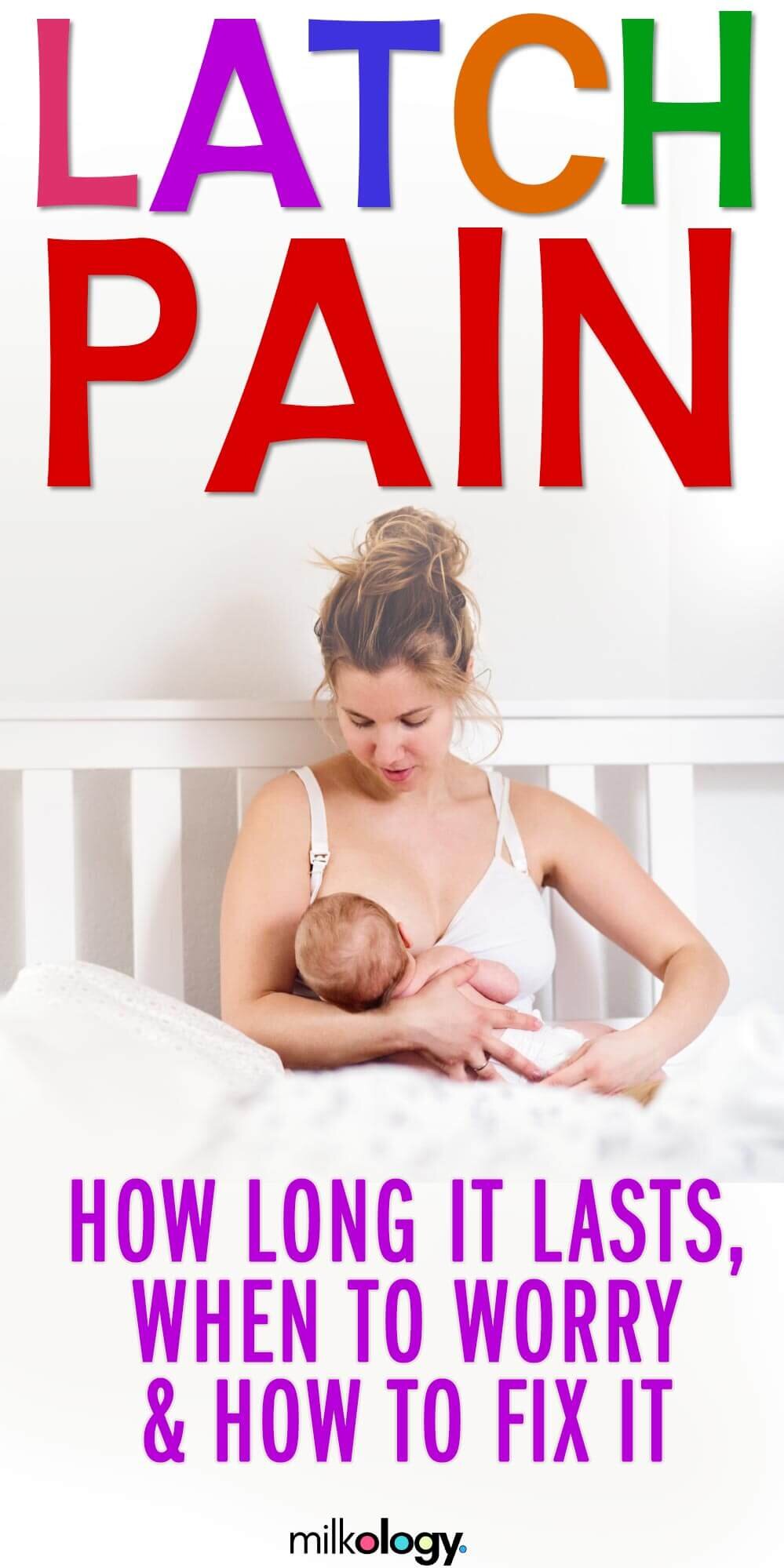When Does Latch On Pain Go Away?
If you experience discomfort when baby is latching during the first couple weeks of breastfeeding, you’re NOT alone!
Studies show that a majority of new moms (as many as 90%) experience some level of nipple pain in the beginning.
It’s no wonder... both you + your baby are learning a new skill!
(there’s definitely an adjustment period while you two learn the ropes)
So the big question still remains: When will latch on pain go away?
To answer this we need to know one thing….
How intense is the pain?
Minor latch discomfort usually resolves itself, but PAIN requires troubleshooting and possibly assistance from a professional if it’s ever going to get better.
(this post may contain affiliate links)
It’s a GREAT idea to take a simple and affordable breastfeeding class. Breastfeeding is something you need to LEARN to do. The Ultimate Breastfeeding Class is on-demand and perfect for new moms.
Ask yourself this question: On a scale of 0-10, how much does the latch hurt?
0 = pain free 10 = toe-curling/wanting-to-scream/can’t-take-it-any-longer
Normal discomfort is 0-4 on the scale.
Abnormal pain is 5-10 on the scale.
NORMAL DISCOMFORT
Latch discomfort will most likely go away with within a couple weeks.
Some nipple soreness can be expected (and is perfectly normal) in the beginning of feedings for the first couple weeks postpartum.
It’s not even actual pain, but more a soreness (or a sensitivity) of the nipples and usually doesn’t indicate a problem.
This type of latch discomfort usually peaks around the third day after birth.
Within a week or two postpartum, nipple sensitivity should be completely gone and breastfeeding should feel like a slight tug at the nipple and nothing more.
The following is all normal:
Discomfort that lasts no more than 30 seconds into the feeding
It doesn’t continue through the entire feeding
No pain between feedings.
No skin damage (cracks, blisters, or bleeding of the nipples)
Your nipples should look the same before and immediately after the feeding (not flattened, creased or pinched)
Essentially normal postpartum nipple discomfort during breastfeeding should not be severe, should be tolerable, should not last throughout the whole feeding session, and be gone within a couple weeks.
But breastfeeding? It should never be downright PAINFUL.
If your nipples are sore, these are an absolute lifesaver. They’re super cheap, can be worn for multiple days (perfect when you’re trying to get a good latch), and are soooo soothing.
ABNORMAL PAIN
With abnormal pain, you need to fix the underlying problem before things will improve.
Latching that extremely hurts is absolutely NOT normal and indicates that a change is needed.
Correct positioning and latch-on are the most important factors in breastfeeding comfort.
Troubleshoot your latching and positioning right away and reach out to skilled lactation help if it doesn’t get better.
“Breastfeeding in the first couple of weeks is like breaking in a new pair of shoes - a little bit uncomfortable at the beginning but you wouldn’t walk around with bleeding feet! Breastfeeding isn’t meant to be painful. So if your nipples are hurting, bleeding, stinging or burning - please reach out to your local IBCLC.””
Abnormal Latch On Pain Experiences That Requires Help
Tenderness that doesn’t go away after 30 seconds of a feeding
Toe-curling pain
Pinching
Pain between feedings
Sensitivity that lasts beyond the first couple weeks
Skin damage (cracks, blisters, or bleeding of the nipples)
The shape of your nipple changes after a feeding (kind of looks like the tip of lipstick)
PRO-TIP: If someone tells you, “The latch looks great!” but you’re hurting and in excruciating pain (or it simply doesn’t feel right), don’t listen to them and go find the skilled lactation help you need!
The GOOD news is that there’s almost always something that can be done to address the problem and alleviate the pain!
Troubleshooting Latch On Pain:
Often a simple change in position or technique can help your baby latch on more deeply and more comfortably.
Switch to a different position
Adjust your baby’s position to help them get a more comfortable latch. Make sure your baby’s stomach is facing your stomach. (tummy-to-tummy) Our favorite position is “laid-back breastfeeding” because it’s easy, comfortable, and naturally encourages a deeper latch for baby.
Change your technique
A good latch starts with the baby’s mouth open wide (like a hungry bird). Encourage baby to get at least an inch of breast tissue in their mouth to get a deeper latch.
If you feel your baby didn’t latch on well, gently break the suction by placing a finger in the side of the baby’s mouth. You can then switch things up and try again.
Tips To Help Get A Good Latch
Hold your baby close, support their neck, and let their head tilt back a bit. Gently stroke your nipple along their upper lip until they open wide. Guide your nipple towards the roof of their mouth and quickly draw them in for a deep latch. Their chin and lower lip should connect with the breast first, covering more of your areola with the lower lip. Keep their chin snug against the breast, but leave their nose free.
Watch out for those cues like finger-sucking, rooting, or little fists near the face. Crying? That's a last-minute hunger alarm! Try feeding before your baby gets super frantic.
Before you latch your little one onto the breast, make sure their mouth is wide open like they're letting out a big yawn. Trust me, it's the key to a comfy feeding session!
Pain relief for latch on pain
You may take a mild pain medication prescribed by your physician for discomfort.
Grab a wet washcloth with some ice in it and give your nipple a quick chill before feeding.
Start a nursing session on the least sore breast first.
Express some colostrum or breast milk and rub into the nipple and areola.
Use a lanolin-based breast cream on your nipples between breastfeeding sessions.
If your nipples are cracked, leave a bit of breast milk on them after a feeding session (your milk can help them heal faster because of antimicrobial properties).
Use hydrogel pads. They create a soothing barrier for sore nipples. These provide relief from material rubbing against your nipples while they heal.
Where to get help if you need Help With Latch On Pain
There are solutions to every cause of latching pain but the trick is to reach out to experienced help to find the solution!
Reach out to a lactation consultant. The best ones are IBCLCs (International Board Certified Lactation Consultants). We call them the “dairy fairies” because they’re the most knowledgeable and trained when it comes to troubleshooting breastfeeding issues!
A good IBCLC can help you diagnose the root cause of the latch on pain and find a solution.
You can also talk to your doc, your baby’s pediatrician, or a local breastfeeding peer counselor. Asking for help? No shame in the game! It's all about doing what's best for your little one and for you
what IBCLCs have say to say about latch pain…
“Oh man, I have an 11 week old at home so it’s so fresh for me! I breastfed my first for two years and was SO ready to breastfeed again but the first 5 days my nipples were tender! I needed to constantly re-position her at my breast and use my other hand to help push my nipple in further to avoid the tenderness. That went away by the end of the first week. Tenderness is normal. Toe curling pain or pinching is NEVER normal and is either a sign that baby is not latched deep enough or there may be a baby structural issue like tongue tie. If you feel any pain or are starting to see any damage, seek help sooner rather than later. If it’s tender but there’s no damage, keep practicing your positioning and latching. If you’re unsure, don’t hesitate to call for help! Lactation consultants LOVE to help teach you to nurse without pain!”
-Julie Matheney, IBCLC at The LA Lactation Lady
“I believe it’s a fallacy to teach that initiating breastfeeding should be without ANY tenderness. There are a lot of nerve endings in the nipple, and the pressure an infant exerts is extraordinary. That said, I often tell moms they can expect an initial nerve response as the nipple adjusts the first couple of weeks. But if discomfort lasts more than the beginning of a feed, or there is continuous pain, sensitivity, cracking, blistering, or bleeding, then infant latch needs evaluation.”
-Holly Beck, IBCLC at The Holding Presence
“I always tell mothers I work with that in the beginning breastfeeding can cause your nipples to feel slightly sensitive. Sensitive is NOT pain. Sensitive is aware of a pulling and tugging. Abnormal is pain, bleeding, cracking, or anything that makes your toes curl. Always ask for help is there is pain and discomfort. Catching it early can help prevent cracking, bleeding, and a continued poor latch.”
-Nicole Kekesi RD, IBCLC at Breastfeeding Resource Center at Virtua
Our 3 Fav Breastfeeding Products
1. 🌙 The night nursing bra you’ll never want to take off
This nursing bra is the absolute BEST for breastfeeding at night. It’s made of the softest material ever. It’s super stretchy with zero digging.
2. 🤱Sore nipples?
If your nipples are sore at all, these are a total game-changer. Pop them on after feeds and let them work. They heal in a matter of hours and you just pop them on after feeding. Wear them 24/7 in the early days.
3. 🍪 Breastfeeding hunger is real
Easy-bake cookies with oats, flax, brewer’s yeast (+ chocolate!) to help support your milk supply and satisfy cravings. Warm, fast, and ridiculously good.
Related latching articles:
9 breastfeeding latch tricks from IBCLCs




